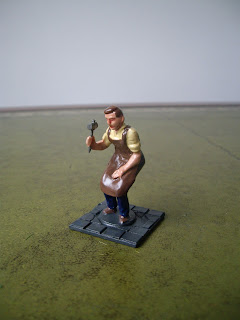NOW I WASN'T EXPECTING THIS
Totally out of the blue a packet arrived on Friday, November 14. To my complete surprise It contained a box of toy soldiers from Brian Carrick. Now I don't really need to mention he is a leading figure in the annual plastic toy soldier gathering held in London. He is also involved in the magazine Plastic Warrior, and I can remember reading articles of his which appeared in Military Modelling dating back to the mid 1980s. This gentleman has been kind enough to occasionally comment on my blog, and often answered some questions which have arisen concerning recent acquisitions, and this has been most helpful. However, He had remembered my interest in a European-made figure of an Alpine hunter with dog. Having acquired several, he kindly gifted an example. If that was not enough, my verbal wish-list to recruit some plastic Robin Hood characters was also answered with a handful of figures to help start this project.
Thank you very much, Brian, for this kind deed. I really value this gesture of support. Just hope you aren't too offended if I seek to convert, paint and base these figures. I think they will look great on my gaming table, and useful too.
I'm going to very much enjoy working on these!
MGB
Postscript.
Later that day I could not resist starting on some of the figures. Decided to remove the flimsy/broken bows and strings on five archers and replace them with unbreakable wire. The broken horn blower also received a head and bow. I then primed them. These reproduced Marx figures are full of detail!Here is that damaged figure, but still useful!
SATURDAY WORK
On Saturday I started working on the remaining nine figures. These three will supplement my trebuchet crew. The Little John figure actually has some chainmail around the shoulders, I think he would look great with a handspike or cranking lever.
This rather splendid and distinctive figure represents Friar Tuck, but I don't think he's fat enough. I've decided to paint it up as a Cistercian monk, in their off-white habit. This order was known to have furnished some military personnel in Spain.
This powerful figure was made in Italy, possibly by Dulcop. With moulded serpents on its shield it really must serve with my Milanese......
Not sure who manufactured this 58mm Robin Hood figure but I will enjoy painting it as Errol Flynn. No RH movie has ever surpassed his
Adventures of Robin Hood (1938). A beautiful colour production that will never become dated..... uncannily, I watched it again only a few weeks ago!


Preview:
https://www.youtube.com/watch?v=X-waFxj7Ijo
Two more figures. I suspect the first is for tree jumping, he carries an arrow in one hand, but no bow or quiver. I think he warrants such items. The other is a rather slight Maid Marian, but will serve better as a young royal.
And finally, a close up of the Alpine hunter with dog. A very nice addition to my collection of plastic rural figures and animals. This character really does deserve a fully textured base.
And here are the nine after some repair work, mould lines removed, and primed.

SOME FIGURES PAINTED AND BASED, NOVEMBER 18
Launched on a determined campaign to complete some of the Medievals generously donated by Brian. They might be toy soldiers, but they reminded me of well detailed 1/35 miniatures sold by Tamiya and others, although they wouldn't last long in a WW2 wargame, lol. Anyhow, here they are with their replacement wire bows. I've also completed the Italian-made knight, ready to command some Milanese retinue.
The tree jumper now has a bow and quiver. I was tempted to add some thread bow strings to these figures, but they probably wouldn't take my rather rough handling and storage system.
Added a sword scabbard, pinned to the torso.
TREBUCHET CREW
Painted and based, Wednesday, November 19.
Have completed the three Robin Hood figures which I felt could be more useful as Ghibelline crewmen for my Trebuchet.
A Stroll in a Bavarian ForestNovember 20. Have painted and based the West German hunting figure. Brian had noted my interest in this toy and having acquired several kindly forwarded one. These figures were originally a freebie with Jacquet chocolates. It's a fun addition to my rural plastic collection.


This leaves just three more to complete from the fifteen. They will appear in my next post.
MGB


































































